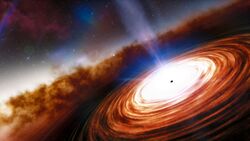Astronomy:J0313–1806
From HandWiki
Short description: Quasar
| J0313–1806 | |
|---|---|
 Artist's impression of quasar J0313–1806 showing the supermassive black hole and the extremely high velocity wind | |
| Observation data (Epoch J2000.0) | |
| Constellation | Eridanus |
| Right ascension | 03h 13m 43.84s |
| Declination | −18° 06′ 36.4″[1] |
| Redshift | 7.6423±0.0013[1] |
| Distance | 13 billion ly (4.0 billion pc) (light travel distance) 30 billion ly (9 billion pc) (proper distance) |
| See also: Quasar,List of quasars]] | |
J0313–1806 is the most distant known quasar at z = 7.64.[1] In January 2021, it was identified as the most redshifted (highest z) known quasar, with the oldest known supermassive black hole (SMBH) at (1.6±0.4)×109 solar masses.[2][3][4] The 2021 announcement paper described it as "the most massive SMBH at z > 7".[5]
One of the 2021 paper authors, Feige Wang, said that the existence of a supermassive black hole so early in the existence of the Universe posed problems for the current theories of formation since "black holes created by the very first massive stars could not have grown this large in only a few hundred million years".[3] The redshift z = 7.642 corresponds to an age of about 600 million years.
See also
- Direct collapse black hole, a process by which black holes may form less than a few hundred million years after the Big Bang
- List of the most distant astronomical objects
- List of quasars
- PSO J172.3556+18.7734
- ULAS J1342+0928
References
- ↑ 1.0 1.1 1.2 Wang et al. 2021.
- ↑ Temming, Maria (January 18, 2021), "The most ancient supermassive black hole is bafflingly big", Science News (Washington, D.C.: Society for Science & the Public) 199 (3): pp. 4, https://www.sciencenews.org/article/most-ancient-supermassive-black-hole-quasar-bafflingly-big, retrieved February 28, 2021
- ↑ 3.0 3.1 Tasoff, Harrison (January 19, 2021), Researchers discover the earliest supermassive black hole and quasar in the universe, https://phys.org/news/2021-01-earliest-supermassive-black-hole-quasar.html, retrieved February 28, 2021
- ↑ "238.01. A Luminous Quasar at a Redshift of z=7.64", American Astronomical Society 237th Meeting, January 12, 2021, https://www.abstractsonline.com/pp8/#!/9243/presentation/1165, retrieved February 28, 2021
- ↑ Wang et al. 2021, p. 4.
Sources
- Wang, Feige; Yang, Jinyi; Fan, Xiaohui; Hennawi, Joseph F.; Barth, Aaron J.; Banados, Eduardo; Bian, Fuyan; Boutsia, Konstantina et al. (2021). "A Luminous Quasar at Redshift 7.642". The Astrophysical Journal 907 (1): L1. doi:10.3847/2041-8213/abd8c6. Bibcode: 2021ApJ...907L...1W.
Further reading
- Alec Fox (January 19, 2021), "This 13-Billion-Year-Old Supermassive Black Hole Is the Oldest Ever Found", Smithsonian, https://www.smithsonianmag.com/smart-news/13-billion-year-old-supermassive-black-hole-oldest-ever-found-180976789/
